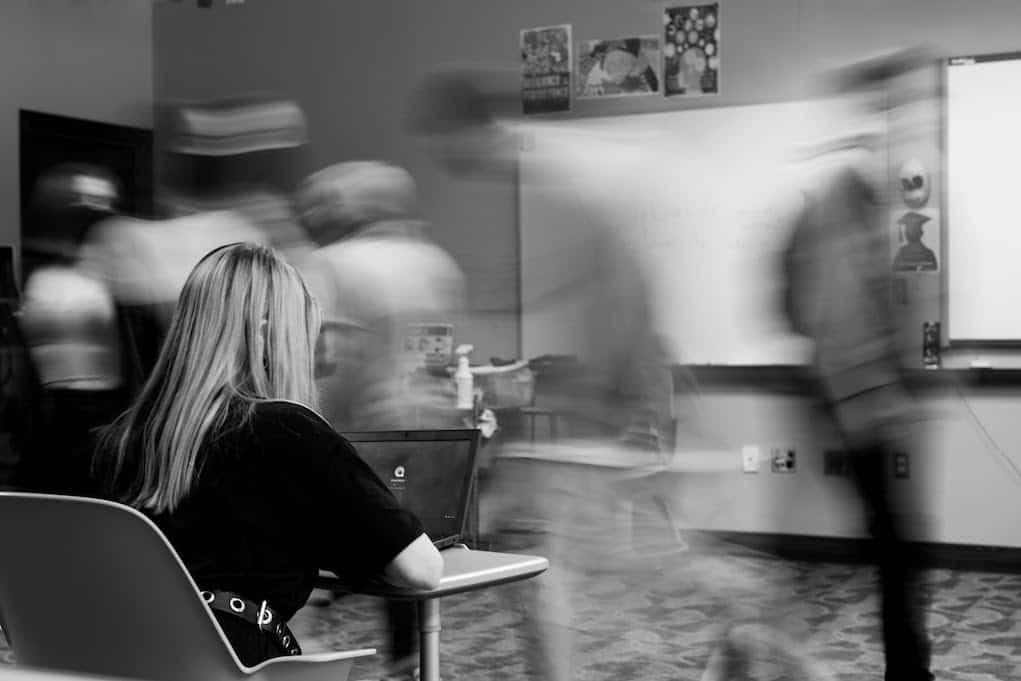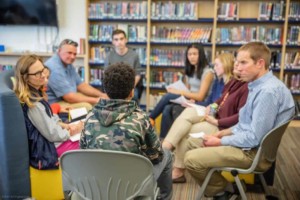Myth of the Ideal Classroom

Image Credit: Kelsea Combs from Kelsea Joy Photography
Article By: Sarah Pazur
Before the pandemic, online learning was a solution for some of the most vulnerable student populations in our country—credit deficient students, expelled students, incarcerated students, and pregnant teen students. Learners, in other words, who would have benefitted from us solving the pre-existing child care, access, and equity issues that the virus illuminated—students who might not have willfully chosen virtual school but make up the profile of the virtual learner nonetheless.
Because schools have historically used online learning to support the struggling or “troubled” student, many parents consider the in-person classroom the Ideal Classroom. This enduring myth of the Ideal Classroom has kept parents and educators from embracing the benefits of online schooling, such as self-paced learning, flexible scheduling, interest-based projects, and global connectedness.
From the point of view of education nostalgists, the Ideal Classroom is what upholds the “moral fabric” of society. The face-to-face (f2f) students are the compliant, mainstream, traditional, “normal” students. Learners forfeit their access to the Ideal Classroom when they fall behind, violate the school handbook, or become young mothers; the remaining students represent the students who played by the rules.
This aversion to online learning reflects who our society believes is and is not worthy of belonging to a f2f classroom. The stigma surrounding online schooling is in fact a bias against the online learner. Make no mistake, for the nostalgist, the specter of the online learner is always racialized, gendered, and othered. For the nostalgist, the f2f learner is the straight white male, the varsity letterman, the prom king.
As a pregnant teen, I contended with adults who questioned whether I deserved to continue my f2f education and then post-partum, questioned whether or not I could learn at a distance. I knew that the presence of my pregnant and young mothering body in the classrooms of my Catholic high school was a threat to the Ideal Classroom and had all the adults worrying: if she is allowed to stay, does it mean we all condone premarital sex?
My pregnancy drew equal scrutiny from boys in my class. The first week that the news hit my high school I received a humiliating message on my parents’ answering machine. The voices of the two teenage boys on the other end blared harsh insults through the speaker into the kitchen. My pregnant body had disrupted everyone’s puritanical version of the Ideal Classroom. Adults and peers made it known: you don’t belong here.
Young moms like me, chronically ill students, incarcerated, displaced, and homeless teens who rely on alternatives to America’s beloved brick-and-mortar institutions know that learning at a distance is not a new challenge. However, the pandemic has suddenly made remote schooling a mainstream preoccupation. When school buildings closed we destabilized the Ideal Classroom and left students and their parents wondering where they “belonged.”
Concerned educators and parents obfuscate their bias against the online learner by arguing that online learning is not as effective as f2f learning; they often cite research that compares the test scores between online and f2f programs. As University of Colorado instructor Chris Hayes points out, this argument uses the erroneous logic of legitimacy to discredit virtual learning.
Researchers who attempt to prove legitimacy by comparing the effectiveness of two different modalities (like online and f2f learning) employ a flawed approach to educational research because a vast array of effective and ineffective pedagogies and teaching techniques exist within both modalities. Teaching is not a monolithic enterprise. Effective teaching isn’t intrinsic to the modality but to the pedagogy. According to the logic of legitimacy that suggests f2f learning is better than online learning, we would endorse a poor educational strategy delivered in a f2f format over an effective strategy delivered in an online environment just because it was delivered f2f.
The results of studies that compare online with f2f consistently arrive at the same conclusion: there is no significant difference in effectiveness between online and f2f education. Thus, as University of Kansas Distinguished Professor and author Yong Zhao argues, it is a futile exercise to compare effectiveness across modalities.
The effectiveness argument encrypts the deeply-entrenched biases against the disenfranchised online learner. The unjust vilification of marginalized virtual students contributes to the illusion that online learning is only for outliers, the students who “can’t make it” in the Ideal Classroom, cementing the idea that online learning is somehow a lesser version of f2f school. These biases harm students who benefit from distance programs and prevent others from taking advantage of distance learning.
The Ideal Classroom is an ancient place. It has stood the test of time because it functions as a microcosm of the white patriarchal structures that many in positions of power, whose children benefit from those structures, subconsciously want to preserve. Despite our modern advancements, despite the fact that we could legislate the necessary resources towards solving child care, access, and equity issues, the timeless impulses of prejudice seize education in their grip.
With adequate funding we’d have the capacity to educate every child in this country—to put technology and internet access into every household so that students and educators can work safely at home—to support the professional growth of every teacher and build the self-efficacy required for online instructional success. With political will, online learning could be a better experience for everyone. Instead of idealizing the f2f classroom at the expense of education’s advancement into the 21st century, it’s time to confront our biases and maximize the opportunities that online learning can provide.
For more, see:
- 5 Ways to Extend Learning and Challenge Learners in the Virtual Environment
- Supporting Student Success in Online Learning
- On the Move to Online Learning
Dr. Sarah Pazur has served in the capacity of teacher, curriculum director, and principal in three different project-based schools in Metro Detroit and principal of a statewide virtual high school. She is now the Director of School Leadership for a network of public school academies across Michigan. She is co-founder of FlexTech Education, a professional development organization specializing in project-based and competency-based learning. Follow her on Twitter at @Saypa.
Stay in-the-know with innovations in learning by signing up for the weekly Smart Update.







Bruce.S
I just went through your blog which is really informative and provided the information for which I was looking for. But during this pandemic, the Idea Classrooms are being converted into Online Education Software. So, it's necessary to choose a good education software that provides a proper online education. According to my personal experience, ConductExam is an Online Exam Software that has all the features and access that online exam software. should have.
So, please kindly visit: http://bit.ly/2HKcvvk